Chu Mu-kun (朱木崑) carefully inspects a large boulder hauled from further up the Daniuci OId Trail (打牛崎古道). “This might work,” he says, rotating and repositioning it against the slope until it fits snugly.
It takes two hours to manually make three steps using simple tools on the ancient trail, which has been rendered inaccessible due to the collapse of a wooden elevated walkway.
“You have to transport goods up here to repair this walkway, which looks jarring against its surroundings to begin with,” Chu says. “Hand-built trails using readily available materials are easier to maintain and are better for the environment. We consider the comfort and safety of the user with each step.”
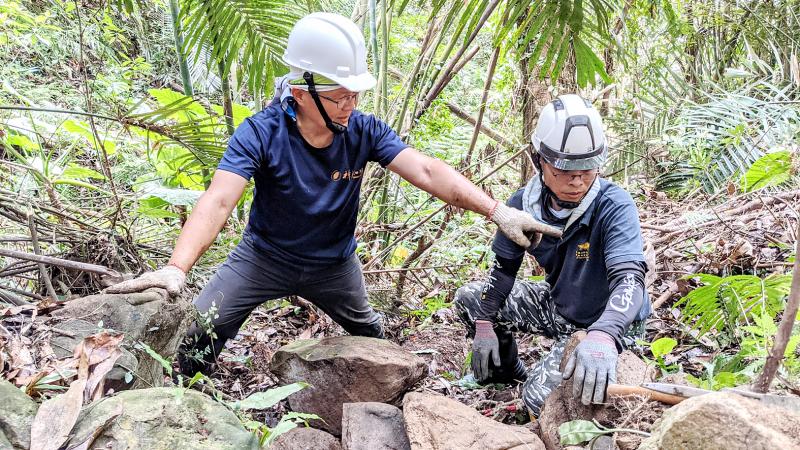
Photo: Han Cheung, Taipei Times
More than 20 people, most of them first-timers including a few children, are participating in the trail-building workshop organized by the Nanshan Community (南山社區) in Hsinchu County’s Guansi Township (關西), and led by six instructors from the Thousand Miles Trail Association (千里步道協會). When complete, the Daniucih Old Trail will be part of the Raknus Selu (樟之細路), a roughly 400km-long network of historic paths connecting mostly Hakka villages from southern Taoyuan to northern Taichung.
The association began promoting the trail in 2018, but it is still very much a work in progress. I was a bit disappointed when I tried to traverse portions of it last month, as little of it was marked and there was scant information along the way. Of course, I could have carefully mapped out the route beforehand, but I completely missed the two main historic paths in the Guansi area and ended up on a paved road for the entire first day. It wasn’t until the next day that I spotted the bright yellow Raknus Selu markers and its hand-built trails on the secluded Shihyingzih Trail (石硬子) near Beipu Township (北埔).
When Hsu Ming-chien (徐銘謙), deputy director of Thousand Miles Trail Association, explains their Appalachian Trail-esque vision, however, it makes sense. Raknus Selu is a massive, ambitious project that requires the cooperation of local enterprises, township and county governments, transportation authorities, historians, trailbuilders and dozens of volunteers, who seem to each work at their own pace.
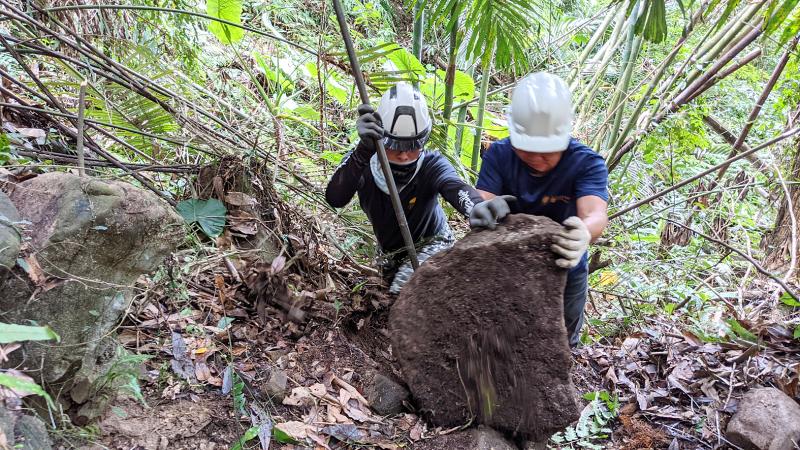
Photo: Han Cheung, Taipei Times
Serious hikers can still try to follow the maps on the Hiking Biji (健行筆記, Chinese only) Web site and try to tackle the route from town to town, but Hsu says for now, it’s probably better to choose a town and identify a few surrounding trails to follow.
“Many international long-distance trails took decades to complete,” Hsu says. “We’re just at the starting point.”
INTO THE WOODS
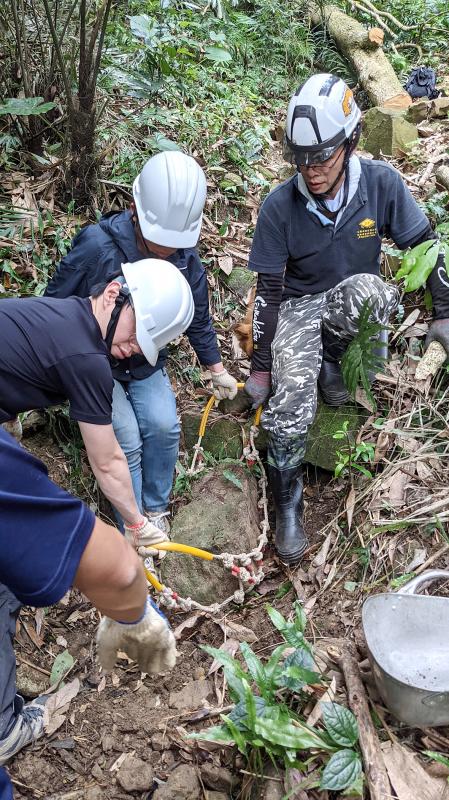
Photo: Han Cheung, Taipei Times
Raknus means camphor in the Aboriginal Atayal langauge, while Selu means small road in Hakka. The trail was used to transport camphor and tea from these hills northward to the Taipei port of Dadaocheng (大稻埕) before it faded into history. It roughly follows Provincial Highway 3, promoted as the “Romantic Highway” to revive tourism in these areas, which suffer from rural flight.
The Shihyingzih Trail is one of six sections that Hsu recommends. It’s not easy to find, and takes over an hour on foot from Beipu to reach — although the journey is quite pleasant, moseying through sleepy settlements and lush farms. The road gets rougher, I can’t get a signal on my phone and we hesitate when we reach a gate marking private property. But the Raknus Selu marker on the tree beyond beckons.
The crop-lined path is completely quiet save for a few dogs, and this is what I imagined the entire trail to be like. We follow the markers deeper into the woods until we finally see the association’s signature handiwork of natural paths cobbled together with wood and stone. This path is about 2km long, and we emerge from the forest to a cluster of well-kept red-brick courtyard houses. Nearby is the Lion’s Head Mountain Scenic District’s (獅頭山風景區) tourist center, where one can explore its network of trails or hop on a bus back to Beipu.
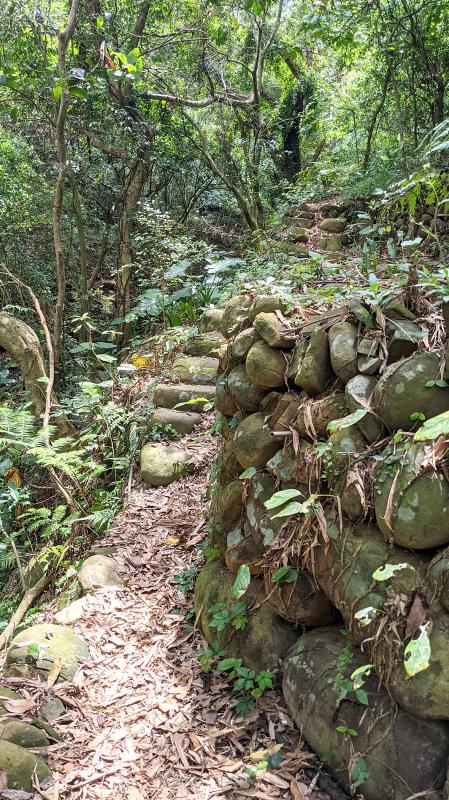
Photo: Han Cheung, Taipei Times
The lady at the tourist center has heard of Raknus Selu, but can offer little information. Hsu says that’s because scenic districts are administered separately from local governments, who are responsible for promoting the road. Ideally, the route’s yellow and blue ribbons would mark the entire route, but local authorities are slow to act due to funding and bureaucracy.
Instead of putting up intrusive information signs or plaques, Hsu hopes local businesses will function as service stations for the Raknus Selu, since community involvement is what will sustain the trails. Local guides at these stations can explain the history and significance of the trails and give visitors suggestions for their trip.
But the association needs to get traffic on these trails first before the communities get on board, Hsu says, and that’s why services aren’t very adequate. But things are slowly moving: Hengshan (橫山), the next major town south of Guansi, has recently expressed interest in helping out.
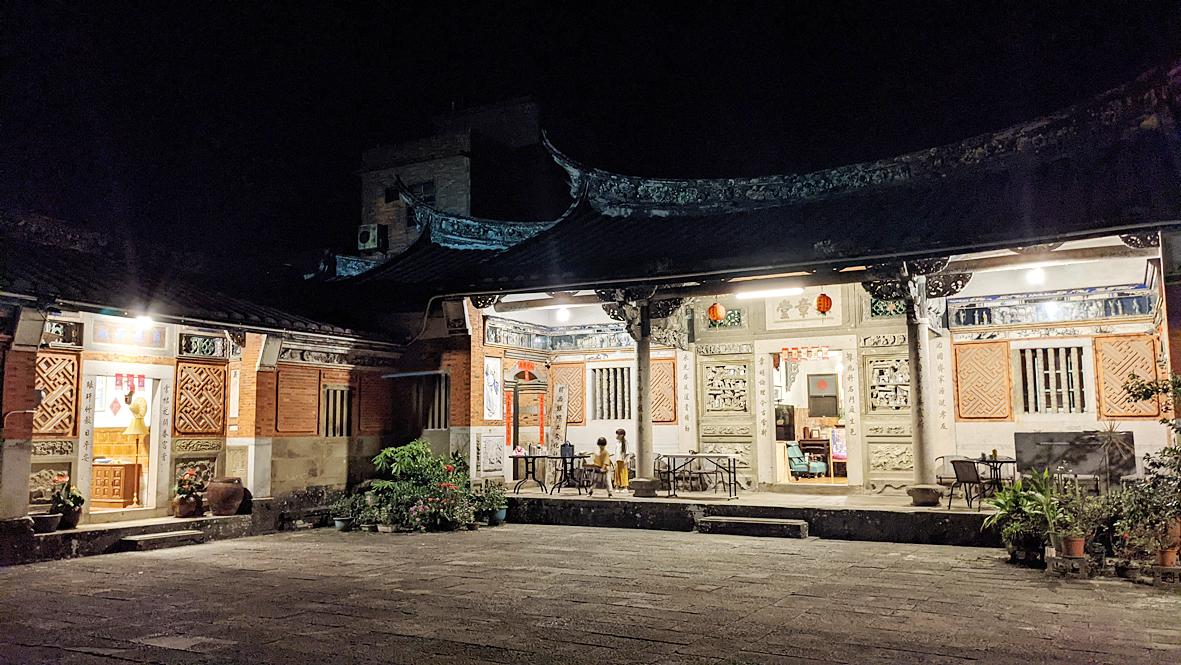
Photo: Han Cheung, Taipei Times
BUILDING CONNECTIONS
Guansi is a good example of the community involvement Hsu speaks of. In fact, it was the Guansi Heritage and Culture Association (關西鄉土文化協會) who reached out to Thousand Miles Trail Association years ago to fix and promote a long-abandoned trail near the Nanshan Community that was used before the neighborhood bridge was built. They interviewed elders to identify the route, and began hosting trail clearing and building workshops to make it usable again. Named the Dunan Old Trail (渡南古道), it is the first entirely hand-built trail on the Raknus Selu.
After the workshop, I visited the Lo Family Traditional School (羅屋書院), a gorgeous hundred-year-old traditional residence turned guesthouse in the community. Steven Lo (羅仕龍), a member of the family who returned from Taipei to run the place, says he always recommends visitors to explore the path. Affable and enthusiastic about local history, Lo is the kind of person needed to make Hsu’s vision a reality.

Photo: Han Cheung, Taipei Times
Lo echoes Hsu’s idea of choosing a town and a few surrounding trails for the Raknus Selu, “unless you’re extremely passionate about walking,” he says.
Miao Mei-chin (繆美琴) of the Guansi Heritage and Culture Association says that the trail goes through windy, sparsely populated mountain roads, and transportation is an issue if trying to go from town to town. Raknus Selu used to connect little villages, she says, but most of them have been abandoned, leaving long, empty stretches along the way. She adds that Hsinchu and Miaoli counties are relatively poorer, which has made the Raknus Selu harder to promote and organize.
Instead, Miao and Lo recommend several loops from the guesthouse through the Dunan Old Trail that range from 5km to 17km. When Daniuci is complete, Miao is looking at offering a two-day trip through several historic trails in the area.
To the community, the trail building workshops are not just to get help to fix the paths, but also a way to garner interest and appreciation of the area.
“When you revisit the path and walk over the steps you made by your own hand, it’s a very different feeling than when you’re normally hiking,” Chu says. “It’s a special connection that you’ll never forget.”
Thousand Miles Trail Association recommends six communities and routes to explore:
‧ Siaocukeng Old Trail (小粗坑) — Sankeng Old Street (三坑), Longtan District (龍潭), Taoyuan City
‧ Dunan Old Trail and Feifeng Old Trail (飛鳳古道) — Guansi Township (關西), Hsinchu County
‧ Shihyingzih Old Trail (石硬子古道) — Beipu Township (北埔), Hsinchu County
‧ Mingfeng Old Trail (鳴鳳古道) — Shihtan Township (獅潭), Miaoli County
‧ Chuguan Old Trail (出關古道) and Guandaoshan (關刀山) — Jiangmayuan (姜麻園), Miaoli County
‧ Laoguandao (老官道) — Dahu Townsnhip (大湖), Miaoli County

The Taipei Times last week reported that the Control Yuan said it had been “left with no choice” but to ask the Constitutional Court to rule on the constitutionality of the central government budget, which left it without a budget. Lost in the outrage over the cuts to defense and to the Constitutional Court were the cuts to the Control Yuan, whose operating budget was slashed by 96 percent. It is unable even to pay its utility bills, and in the press conference it convened on the issue, said that its department directors were paying out of pocket for gasoline

On March 13 President William Lai (賴清德) gave a national security speech noting the 20th year since the passing of China’s Anti-Secession Law (反分裂國家法) in March 2005 that laid the legal groundwork for an invasion of Taiwan. That law, and other subsequent ones, are merely political theater created by the Chinese Communist Party (CCP) to have something to point to so they can claim “we have to do it, it is the law.” The president’s speech was somber and said: “By its actions, China already satisfies the definition of a ‘foreign hostile force’ as provided in the Anti-Infiltration Act, which unlike

That US assistance was a model for Taiwan’s spectacular development success was early recognized by policymakers and analysts. In a report to the US Congress for the fiscal year 1962, former President John F. Kennedy noted Taiwan’s “rapid economic growth,” was “producing a substantial net gain in living.” Kennedy had a stake in Taiwan’s achievements and the US’ official development assistance (ODA) in general: In September 1961, his entreaty to make the 1960s a “decade of development,” and an accompanying proposal for dedicated legislation to this end, had been formalized by congressional passage of the Foreign Assistance Act. Two

Despite the intense sunshine, we were hardly breaking a sweat as we cruised along the flat, dedicated bike lane, well protected from the heat by a canopy of trees. The electric assist on the bikes likely made a difference, too. Far removed from the bustle and noise of the Taichung traffic, we admired the serene rural scenery, making our way over rivers, alongside rice paddies and through pear orchards. Our route for the day covered two bike paths that connect in Fengyuan District (豐原) and are best done together. The Hou-Feng Bike Path (后豐鐵馬道) runs southward from Houli District (后里) while the